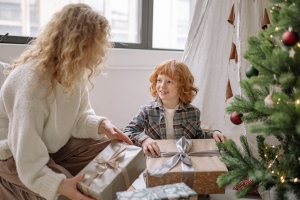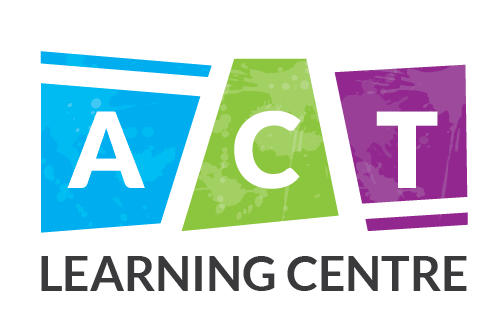A Holiday Gift Guide for Play and Development
The holidays are almost here, which may lead you to ask… “What sort of gifts would be good for my child?”. Many toys can be used as tools for play and language development and the holidays can be a great time to find items to match your child’s interests and to support development at different levels.
Here are some gift inspirations for every type of player…

The Sensory World Explorer
If your child is super engaged in the world around them, but not yet consistently with people or toys, consider what sensations they enjoy, and lean in! While marketing tells us we need flashy toys for our kids, often our Sensory World Explorers may have a hard time shifting attention between toys and us. Making ourselves a part of the routine is key. Think about how you can take a sensation your child enjoys and make yourself part of that sensation or routine. For example:
Bubbles: For kids who love visuals. Add play sounds like “pop” and narrate what your child is doing (e.g., “You popped it!”) to help them explore their world.
Fuzzy Blanket: Wrap your child up nice and tight for comforting squishes or hide them in the blanket for an engaging game of peek-a-boo. This leads to lovely play routines like “Where did you go? There you are!”.
Sensory Bins: If your child likes to touch and explore, try creating a new sensory experience. Make edible sand out of cheerios, use shaving cream and washable paint to make potions, hide items in playdoh or dig with little shovels through rice in a bin. Sensory bins can be an opportunity to talk about actions (e.g., “Pour rice!”), sensations (e.g., “Ewww squishy playdoh”), and emotions (e.g., “You love to paint!”).
The Cause-and-Effect Captain
If your child likes repetitive play actions or repeats a single action over and over, they may be a Cause-and-Effect Captain. Although it may seem like they have a play routine figured out on their own, there is always something that you can add to the game, whether it be a new step, new language or engagement in turns. Cause-and-effect play can always be just a little more exciting. For example:
Blocks / Magnetic Tiles: These little stackable toys have more opportunities for exploration than they may appear. Blocks can be stacked “up, up, up”, can come crashing down “boom” or could even support more complex concepts like first/last, big/small, over/under.
Suction Type Toys: Stick, squish, drop, throw… there are lots of actions that you can model, follow and name while you play with these toys. Silly exploration can include sticking your toys in different places, like the window, the fridge or even somebody’s head!
Marble Run or Cars and Ramp: These toys can include both construction and cause-effect components. Depending on your child’s interest and current building abilities, you can help them create an even better environment to move their toys and to watch them move, roll, jump and crash! These toys also lend themselves to some awesome play sounds like “zoom”, “vroom”, “crash”, “boom” and “weeee”.
The Imaginary World Builder
If your child is starting to enjoy imaginary play, functional or more abstract, they are exploring the world in a new way! Consider how you can continue to help them build their imagination and narrative skills.
Trip to a New Place: Think about the zoo, a museum, a new park or someplace to discover new ideas and challenges. You can be your child’s guide to the new place, by modeling how to participate and by naming their actions and feelings. Exposure to new experiences is a great way to increase vocabulary. Reading stories on those new places (whether social stories or fiction stories) can help prepare your child for the outing and support them in talking about it again after you’ve visited.
Farm or Home/food Sets: Think of toys with multiple parts, that can do multiple things. On the farm, animals can run, jump, eat, sleep, play, get dirty and then be washed or otherwise cared for… there are many different ways to talk about what, where, when, why and how. These concepts are important for imaginary play, but also for general language skill development.
Research tells us that children learn their absolute best when they are engaged in play with play partners. The more engaged children are in person-to-person communication and interaction, the more opportunities they have to learn and develop new skills. Don’t forget that outings, experiences and quality time are wonderful gifts that will support your child’s learning without requiring toys!
Quick Tips: No matter what type of player you have at home, consider the following:
You’re #1: Children learn most in play when they’re with an engaging play partner. You are the most exciting partner that your child can play with. Building routines together, modeling play and the language surrounding your play will give your child the tools they need to develop.
Limit Tech: Research tells us that technology limits the amount and quality of communicative interactions between children (with ASD and otherwise) and their communication partners. It is also tough to compete with an iPad or flashy toy that lights up or makes lots of sounds! Instead, focus on things you can do together if you want playtime to be development time.
Wait, Watch, Listen: Observe how your child likes to play and explore their world, then see how you can join in. Your creativity, language and experience mean that you can make any play interaction just a little more fun… and that is what we want! By showing your child you are interested in how they play, you are showing them that you can make their world even better.
Forget the Batteries: Sometimes the easiest way to use a battery-operated toy with engagement in mind is to “forget” the battery! Think creatively about what else you can do with a toy, even if it does not light up or make noise. Exploring together why it is “broken” can also be an engaging activity.
Less is More: Research tells us that toys that are busier (think flashy, bright, electronic) often result in adults modeling less language. If supporting development is your goal, you want to aim for items that offer plenty of opportunities to talk, and fewer interruptions by the toy itself.
What’s Your Goal? Ultimately, you want to choose gifts that will fulfill their purpose. If you want a gift that will occupy your child while you are busy, then something exciting and flashy might be just the ticket. And there is no shame in wanting just that! However, if you are interested in play that you and your child can engage in together, focusing on items that include you in the routine is key.
Whatever gift you choose this year, the best part of the fun will be finding ways to connect with your loved ones. We at ACT wish you a warm holiday season and hope this guide brings a little extra joy and learning to you and your child.
“Parents should be assured that they (not the toys) are the most important part of play interactions and that no toy can take the place of an engaged play partner.”
– Sturman et al., 2022
Jane Woodworth,
ACT Learning Centre Speech-Language Pathologist
Other helpful articles:
https://www.frontiersin.org/articles/10.3389/fpsyg.2022.929589/full
https://jamanetwork.com/journals/jamapediatrics/article-abstract/2792045
https://jamanetwork.com/journals/jamapediatrics/article-abstract/2792045
https://jamanetwork.com/journals/jamapediatrics/article-abstract/2792045
https://www.sciencedirect.com/science/article/pii/S0163638321000643?via%3Dihub


